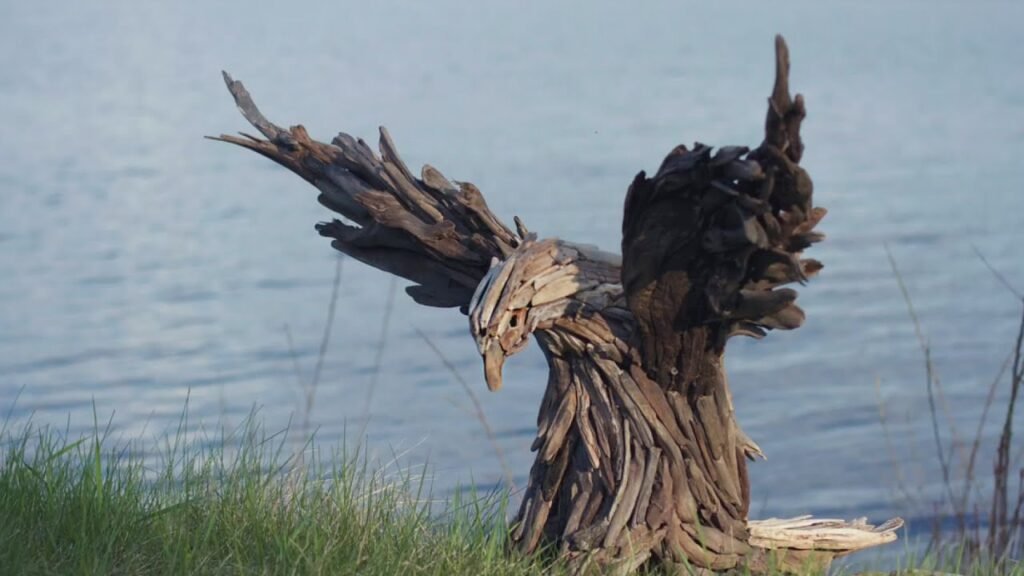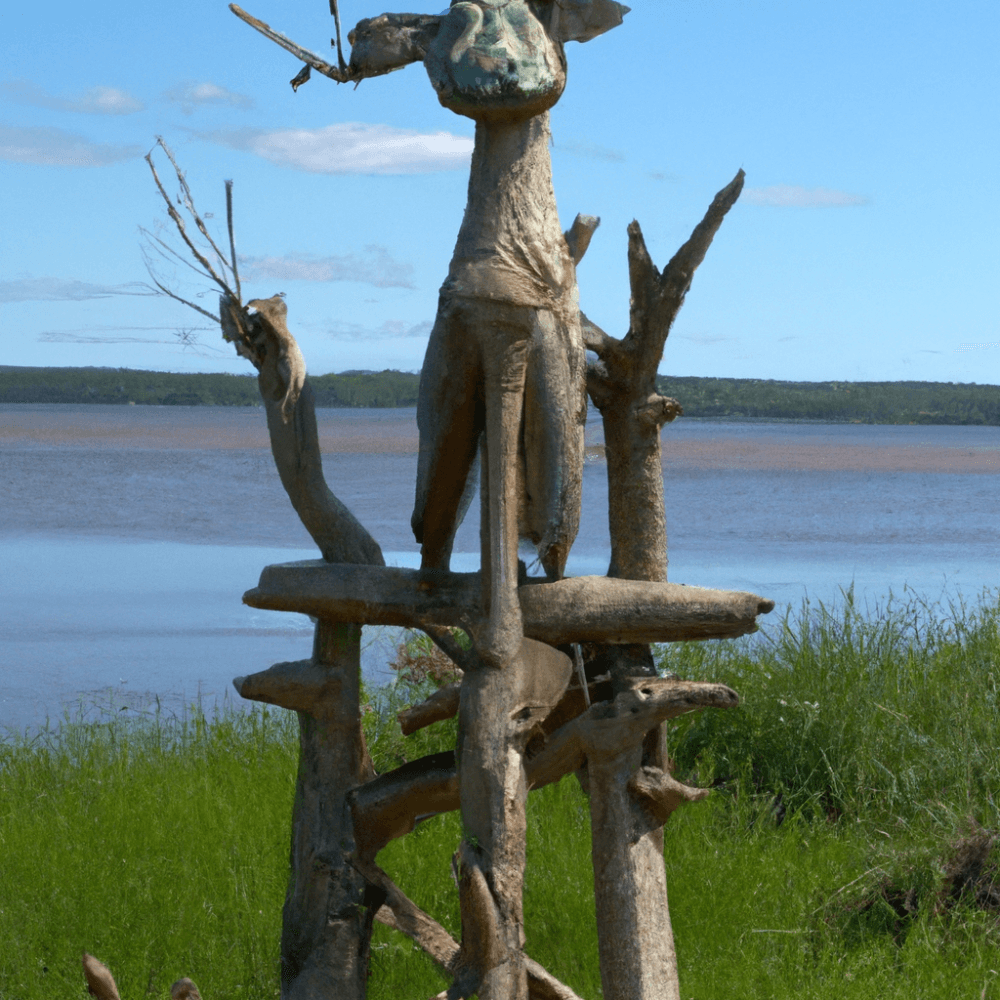In this week’s “Finding Minnesota” segment by WCCO – CBS Minnesota, we discover the fascinating world of driftwood art. Jennifer Zerback, an artist from Moose Lake, has transformed pieces of driftwood from Lake Superior into stunning works of art. With her sculptures resembling various animals, Zerback’s creativity and imagination are on full display. She stumbled upon this unique art form about 15 years ago when she found a piece of driftwood that looked like a moose while walking on a beach. Since then, she has created approximately 140 driftwood pieces featuring animals like bears, ducks, and eagles, using hundreds of pieces of driftwood to bring them to life. This treasure hunting-like process of finding the right pieces of driftwood and putting them together like a puzzle is what makes working with driftwood so much fun for Zerback. Her artwork has gained recognition and can now be found in galleries, homes, and restaurants across the country.
Section 1: Introduction
Have you ever walked along a beach and stumbled upon a piece of driftwood? Most of us would simply kick it to the side, dismissing it as a mere piece of debris. But for Jennifer Zerback from Moose Lake, Minnesota, that same piece of wood holds tremendous potential. In this article, we will take a closer look at Jennifer’s fascinating journey into the world of driftwood art and how she transforms ordinary pieces of driftwood into stunning works of art.
Section 2: Jennifer Zerback’s Journey to Driftwood Art
2.1 Jennifer’s inspiration for driftwood art
Jennifer Zerback’s love for driftwood art was ignited about 15 years ago when she and her husband, Kevin, took a trip away from their kids. While walking along Wisconsin Point, Jennifer came across a piece of wood that resembled a moose. Intrigued by the natural shape and texture, she decided to create a sculptural representation of a moose using the driftwood. Little did she know that this small act would set her on an artistic journey that would change her life forever.
2.2 Discovering her passion for sculpting
Although Jennifer had been painting in a “van Goghish” style, it was the process of sculpting driftwood that captured her heart. Growing up without a television and having the freedom to explore the countryside allowed Jennifer to cultivate a vivid imagination. Sculpting provided her with an outlet for her creativity and a medium through which she could bring her imaginations to life.
2.3 Finding the perfect driftwood piece
One of the remarkable aspects of Jennifer’s artistry is her ability to identify the perfect piece of driftwood to bring her vision to life. While Kevin, her husband, may not always have the same eye for it, Jennifer has developed an instinct for recognizing the potential in each piece of driftwood. The knots and unique shapes found in the driftwood serve as inspiration for her sculptures, guiding her in the journey of creating breathtaking and realistic pieces.

This image is property of i.ytimg.com.
Section 3: The Process of Creating Driftwood Art
3.1 Jennifer’s creative process
Jennifer’s creative process starts with a vision or an idea for a particular animal or object she wants to sculpt. Armed with this vision, she begins the process of selecting the most suitable driftwood pieces. Each piece is carefully examined and evaluated based on its shape, texture, and overall fit with the intended design.
3.2 Selecting and preparing the driftwood
The selection process is crucial to Jennifer’s artistry. She looks for pieces that mimic the natural curves and contours of the animal she plans to sculpt. Driftwood with knots and unique shapes are particularly valuable as they can be utilized to create eyes or other important features of the sculpture.
Once the driftwood pieces are chosen, Jennifer cleans and prepares them, removing any debris or loose bark. This step is essential to ensure that the final sculpture has a clean and polished appearance.
3.3 Assembling the pieces
With the cleaned and prepared driftwood pieces in hand, Jennifer begins the process of assembling them to create her desired sculpture. Like a puzzle, each piece is carefully fitted together, considering the natural curves and features of the animal she is sculpting.
Jennifer’s hands and eyes never cease moving during this process, constantly evaluating and adjusting the position of each driftwood piece to achieve the desired result. It is through this meticulous assembly of driftwood that the sculptures begin to take shape and come to life.
3.4 The role of glue and screws in the artwork
To ensure the durability and stability of her sculptures, Jennifer uses a variety of glues and screws. These help to hold the driftwood pieces together, ensuring that the artwork remains intact and can withstand the test of time. The careful application of glue and strategic placement of screws are essential in preserving the delicate balance and intricate details of her creations.
Section 4: The Magic of Driftwood
4.1 Exploring the unique characteristics of driftwood
One of the enchanting aspects of driftwood art is the inherent beauty and uniqueness found in each piece of driftwood. No two pieces are alike, and each carries its own story, shaped by the tides and weathering of the water. The natural weathering process gives driftwood its distinct texture, color, and character, which Jennifer skillfully incorporates into her sculptures.
4.2 The joy of treasure hunting for new pieces
For Jennifer, the process of creating driftwood art is not only about craftsmanship but also about the joy of treasure hunting. Walking along the beach, scouring the shorelines, and exploring hidden coves in search of the perfect driftwood pieces is an exciting and rewarding experience. Each new piece discovered holds the promise of endless possibilities and sparks Jennifer’s imagination for future projects.
4.3 The endless possibilities of driftwood art
Driftwood art allows for limitless creativity. The organic shapes and contours of the driftwood lend themselves to a wide range of artistic interpretations. From majestic wildlife sculptures to intricate and delicate designs, the unique characteristics of driftwood provide artists like Jennifer with endless inspiration and possibilities.

Section 5: Jennifer Zerback’s Impact and Success
5.1 Showcasing Jennifer’s art in galleries
Jennifer Zerback’s talent and passion for driftwood art have garnered attention and recognition from art enthusiasts and collectors. Her beautiful sculptures have found their way into galleries, where they have been showcased and admired by a wide audience. Jennifer’s ability to infuse life into driftwood has captivated many, leaving a lasting impression and sparking a renewed appreciation for nature’s artistry.
5.2 Displaying her art in homes and restaurants
Beyond galleries, Jennifer’s art has found its place in homes and restaurants across the country. The unique and stunning appeal of driftwood art allows it to seamlessly blend with various interior design styles, adding a touch of natural elegance to any space. By displaying her art in these venues, Jennifer brings joy and inspiration to individuals in their everyday lives.
5.3 Recognition of Jennifer’s talent
Jennifer Zerback has gained recognition and acclaim for her incredible talent and contributions to the world of driftwood art. Her dedication to her craft, meticulous attention to detail, and unwavering passion have set her apart in the artistic community. Jennifer’s success serves as an inspiration to aspiring artists and showcases the power of following one’s passion.
Section 6: Conclusion
Jennifer Zerback’s journey to driftwood art is a testament to the transformative power of following one’s true calling and the beauty that can be found in unexpected places. Through her incredible creativity and skill, she has turned ordinary pieces of driftwood into stunning works of art that inspire and captivate. As we have explored her process and the magic of driftwood, we have gained a deeper appreciation for the art form and the endless possibilities it holds. Jennifer’s impact and success serve as a reminder to embrace our passions and never underestimate the potential in the world around us.



